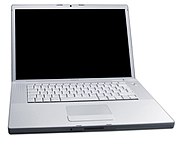
A laptop computer, also known as a notebook computer, is a small personal computer designed for mobile use. A laptop integrates all of the typical components of a desktop computer, including a display, a keyboard, a pointing device (a touchpad, also known as a trackpad, or a pointing stick) and a battery into a single portable unit. The rechargeable battery is charged from an AC/DC adapter and has enough capacity to power the laptop for several hours.
A laptop is usually shaped like a large notebook with thickness of 0.7–1.5 inches (18–38 mm) and dimensions ranging from 10x8 inches (27x22cm, 13" display) to 15x11 inches (39x28cm, 17" display) and up. Modern laptops weigh 3 to 12 pounds (1.4 to 5.4 kg), and some older laptops were even heavier. Most laptops are designed in the flip form factor to protect the screen and the keyboard when closed.
Originally considered "a small niche market" and perceived as suitable for "specialized field applications" such as "the military, the Internal Revenue Service, accountants and sales representatives", battery-powered portables had just 2% worldwide market share in 1986. But today, there are already more laptops than desktops in the enterpriseand, according to a forecast by Intel, more laptops than desktops will be sold in the general PC market as soon .
Desktop replacement

The names "Media Center Laptops" and "Gaming Laptops" are also used to describe this class of notebooks.[10]
Subnotebook

A subnotebook, also called an ultraportable by some vendors, is a laptop designed and marketed with an emphasis on portability (small size, low weight and long battery life) that retains the performance of a standard notebook. Subnotebooks are usually smaller and lighter than standard laptops, weighing between 0.8 and 2 kg (2 to 5 pounds)[10]; the battery life can exceed 10 hours[13] when a large battery or an additional battery pack is installed.
To achieve the size and weight reductions, ultraportables use high resolution 13" and smaller screens (down to 6.4"), have relatively few ports, employ expensive components designed for minimal size and best power efficiency, and utilize advanced materials and construction methods. Some subnotebooks achieve a further portability improvement by omitting an optical/removable media drive; in this case they may be paired with a docking station that contains the drive and optionally more ports or an additional battery.
The term "subnotebook" is usually reserved to laptops that run general-purpose desktop operating systems such as Windows, Linux or Mac OS X, rather than specialized software such as Windows CE, Palm OS or Internet Tablet OS.





No comments:
Post a Comment